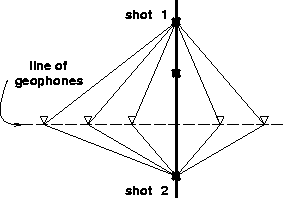![[*]](http://sepwww.stanford.edu/latex2html/cross_ref_motif.gif) ),
and thus, the shot axis can not be processed in parallel.
),
and thus, the shot axis can not be processed in parallel.
The parallel implementation of DMO in a two-dimensional space is straightforward. Biondi 1991 describes a simple algorithm where the traces are laid out local to each processor. The DMO process then consists of a trace stretch and a nearest neighbor shift along the midpoint axis.
In three dimensions, the data shift is not restricted to a single
axis but requires a movement of the input traces across a two-dimensional
space. Biondi 1992 uses the same layout to
apply DMO to 3-D marine data. The algorithm
takes advantage of the regular data movement in the in-line direction
because of the uniform sampling of the shot locations.
However, 3-D land surveys record shot profiles
of varying geometry (an example is shown in Figure ![[*]](http://sepwww.stanford.edu/latex2html/cross_ref_motif.gif) ),
and thus, the shot axis can not be processed in parallel.
),
and thus, the shot axis can not be processed in parallel.
|
land3d
Figure 1 This simple 3-D land acquisition geometry exhibits the non-recurrence of the shot profiles. As opposed to marine surveys, the geophone line does not move along with the shot location. |  |